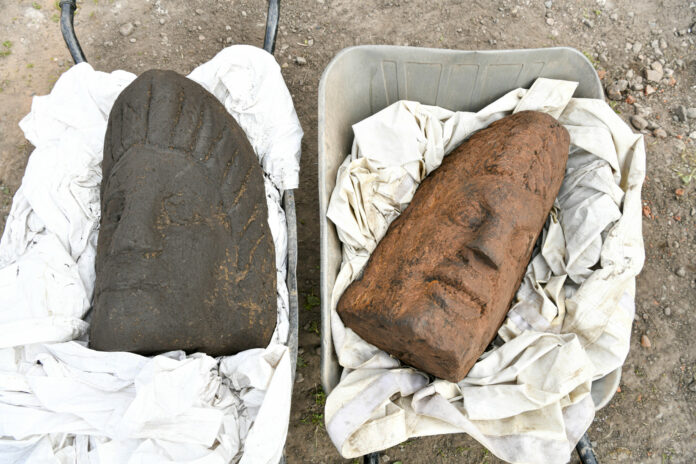Two huge Roman head sculptures have been found at a sports club, in what archaeologists have described as “finds of a lifetime.”
Volunteers uncovered the carved sandstone artifacts, thought to be around 1,800 years old, during a dig this week at a cricket club in Carlisle—a city located in the far north of England, close to the border with Scotland.
The discovery of the sculptures, which stand around 2 feet high, is the latest find at Carlisle Cricket Club. Previous excavations at the site have uncovered a huge Roman bathhouse, as well as a number of extraordinary items.
“This is exciting news and is a real coup so early into the dig. It is a significant find and it is great to hear that they were unearthed by volunteers,” Councillor Anne Quilter with Cumberland Council said in a statement. “Carlisle has a rich Roman history, and this further strengthens the city’s connection to that era. I can’t wait to see what else is found!”
Stuart Walker Photography
Carlisle once sat at the edge of the Roman Empire. Hadrian’s Wall, the iconic 73-mile-long defensive structure that marked the empire’s northernmost border, runs past the city. The bathhouse uncovered at Carlisle Cricket Club is the largest-known building along the Wall.
The latest archaeological dig at the cricket club—part of the U.K.-government funded 2023 Uncovering Roman Carlisle project—involved hundreds of volunteers, some with no prior experience of archaeology.
The head sculptures were found by the side of an ancient cobbled Roman road on the second day of the dig, within the grounds of the cricket club on some redundant grassland, Sarah Irving with Cumberland Council told Newsweek.
“It’s been an incredible two days into the project; it’s the first sculpture found from the site and could be the find of a lifetime,” lead archaeologist Frank Giecco said in a statement. “This truly shows the significance of the bathhouse and raises the site to a whole new level of importance with such monumental sculpture and adds to overall grandeur of the building.”
The heads, which are exceptionally well-preserved, have probably been hidden since the fifth century when the Roman road fell out of use. Eventually, they became covered by earth.
“Part of the building was probably robbed for building materials; and these two heads were just left at the side of the road,” Giecco told local daily newspaper the News & Star. “An educated guess would be that they were part of the huge bathhouse on the site.”
It is likely that the carved heads once formed part of full-figure sculptures that stood around 12 to 15 feet in height, the BBC reported.
Figures are not unusual finds at Roman bathhouses, according to Giecco, but he told the BBC that sculptures of this size are “really special.” He added that the finds were “unique and priceless” artifacts.
“In 30 years of being an archaeologist, I’ve never found a thing like this before,” Giecco told the BBC. “You can probably count on one hand examples of this kind in Britain.”
The heads may be depictions of Roman gods. Giecco said the female head may represent Fortuna, the Roman goddess of chance, for example. But archaeologist Jo Beaty told the Star that the heads might be depictions of Emperor Lucius Septimius Severus, who ruled the empire from 193 to 211, and his queen Julia Domna.
More than 1,000 artifacts—including pottery, weapons and coins—have been found during excavations conducted at the site after the initial discovery of the bathhouse in 2017.
Among these artifacts are a set of more than 30 carved gemstones and tiles indicating that Septimius Severus had connections to the site.
Several pieces found at the site will be displayed as part of an exhibition at the British Museum in London in 2024.


